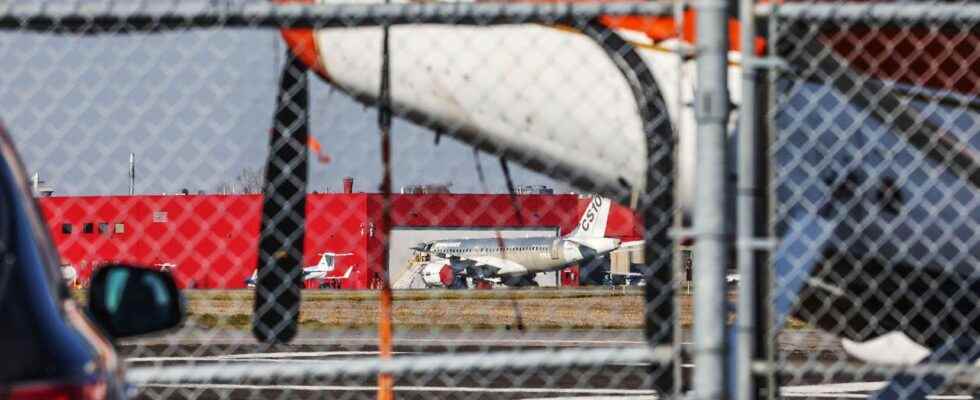Nearly a year after her election, the mayoress of Longueuil takes a stand on the delicate issue of Montreal Saint-Hubert Airport by declaring herself “strongly unfavorable” to hosting international flights. Rather, Catherine Fournier wants to make this territory an international aeronautics center for research and development of less polluting technologies.
“We do not believe that [l’avenir de l’aéroport] is done through the project of developing low-cost international flights with old planes. It is not a vision to which we subscribe, ”said Mayor Catherine Fournier during an interview with The duty at Longueuil City Hall, located a stone’s throw from the first Canadian airport.
Her position, she knows, will be perceived as “a break” with those of previous administrations. These supported the desire of Développement Aéroport Saint-Hubert de Longueuil (DASH-L), a non-profit organization that owns the airport, to expand its activities by welcoming international flights.
A desire confirmed in the spring of 2021 by DASH-L, which presented the main lines of a development plan which, in addition to regional and national flights, worked on an international flight offer, particularly to sun destinations. The objective is to ensure these connections thanks to the arrival of low-cost airlines. Neither the development plan nor the studies on which it was based have been made public.
“Is there really a need to develop international flights in Longueuil? No study proves it. And we need data and information to make decisions and develop guidelines. There have never been studies of the economic repercussions in terms of jobs or other types of benefits,” she explains.
Against any legislative change
Moreover, legally, Saint-Hubert airport cannot accommodate international flights. A lease between Transport Canada and Aéroports de Montréal (ADM) grants their exclusivity to the latter until 2072. And ADM recently spoke out against any legislative change that would allow Aéroport Montréal Saint-Hubert to provide international connections.
Regarding the city’s opposition to international flights, DASH-L communications director Bernard Gervais says the organization recently revised its position. Without putting a cross on international flights, the airport does not wish to “push” the idea of sun destinations as vigorously as before.
Mr. Gervais believes that consumer demand will dictate the position to be taken. “If people take regional flights, from Gaspésie for example, and they find that a change of airport to make their connections to the United States poses a problem, they will say so and depending on the request, we will see. »
Expected, the position of the City follows the publication this week of a first report by the Office of Public Participation (OPPL) relating precisely to the future of the airport. Enshrined in the Ville de Longueuil Charter since June, this independent organization’s mission is to survey residents in order to formulate recommendations.
We learn that the majority of Longueuil residents are not opposed to the increase in the number of thefts. Moreover, the situation changes when we look at the comments and fears expressed by citizens who live near the airport. Of the 8,050 people who responded to an online questionnaire, 53% live in the borough of Saint-Hubert, including 61% less than three kilometers from the airport. Result: 54% say they are against an increase in traffic and 77% anticipate potential environmental impacts.
“But people are not closed to the development of the airport, assured the mayor. Development still needs to be done responsibly first, with transparent governance [de l’organisme qui gère l’aéroport]. »
Develop less polluting devices
She confirms that she has a plan in her boxes for the airport area. His administration intends to transform the latter into an innovation center in aeronautics and aerospace revolving around research on less polluting devices, “a project which could become the most important in the history of Longueuil”.
To breathe life into it, the municipality intends to rely on the land it owns, which exceeds 400,000 m2. It is also in discussion to acquire lots whose area would reach 93,000 m2. If the transactions are confirmed, the City will hold an area of land equivalent to 75 football fields for the development of this pole.
Councilor Geneviève Héon will chair the working table, whose mandate this year will be to draw up a development plan for the airport zone. The goal is to create “the link between the economic environment, that of research and innovation, and the knowledge environment in general”. Longueuil does not rule out integrating sustainable and integrated mobility organizations into this hub, she specifies.
“We are delighted with the City’s position,” said Sylvain Lambert, director general of Cégep Édouard-Montpetit and the École nationale d’aérotechnique (ENA), an establishment that offers training in avionics, engineering aerospace and aircraft maintenance.
Already, the establishments he directs are working on the development of an innovation zone in the sector. They have projects with Pratt & Whitney and Héroux-Devtek, already in the sector, but also with CAE, in connection with the electric aircraft sector. “There is also the Canadian Space Agency which is there, with whom we could collaborate. The idea would be to create an innovation zone around new technologies and green planes, the development of devices that rely on new fuels. »
With the will of the City, other research centers should soon be added to the project, such as the ETS and the University of Sherbrooke, already present in Longueuil.
As for DASH-L’s position on an innovation zone? “We would be 100% behind an initiative from the City that would go in this direction, launched Bernard Gervais. Whether it’s projects going in the direction of electrification or any other project of the kind, we are behind that. We can’t be against it, that’s where the future of aviation lies. »
